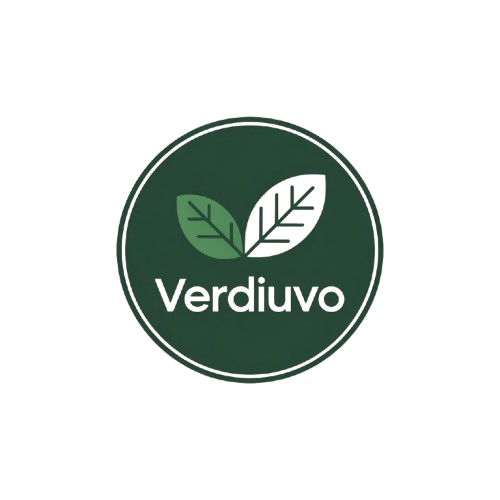Non-Toxic Cookware: 10 Home Cook Tested Brands for a Healthier Kitchen (2025)
For health-conscious home chefs and clean cooking enthusiasts, the quest for truly Non-Toxic Cookware is more than a trend – it’s a fundamental shift towards a safer, more sustainable kitchen. Gone are the days of unknowingly exposing ourselves to harmful chemicals leaching from pots and pans. In 2025, innovation and demand have driven an exciting market of cookware designed to prioritize wellness without sacrificing performance. This guide cuts through the noise, presenting 10 rigorously home cook-tested Non-Toxic Cookware brands that deliver on safety, functionality, and durability. Discover your path to cleaner, more conscious cooking.
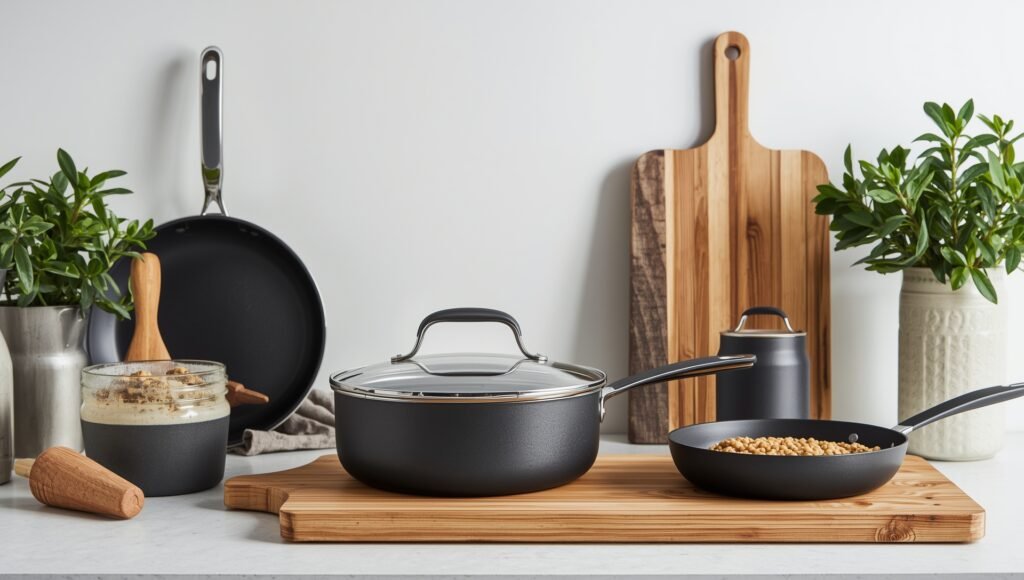
What Exactly is Non-Toxic Cookware? (And Why It Matters)
Non-Toxic Cookware refers to pots, pans, and bakeware manufactured without harmful chemicals that can migrate into food, especially when heated. The primary culprits to avoid include:
- PFAS (Per- and Polyfluoroalkyl Substances): Often called “forever chemicals,” used in traditional non-stick coatings (like Teflon™). Linked to serious health concerns even at low exposure levels.
- PFOA (Perfluorooctanoic Acid): Previously used in non-stick production (largely phased out but still a concern with older or unverified products).
- Lead & Cadmium: Sometimes found in glazes or decorations on ceramic or enamelware.
- Aluminum (Uncoated): Can leach into food, particularly acidic ingredients like tomatoes. Safer when fully clad or anodized.
- Synthetic Polymers of Unknown Safety: Newer non-stick coatings must be rigorously vetted.
Safe materials forming the backbone of non-toxic cookware include:
- 100% Ceramic (Unglazed): Made from natural clay and minerals, free of metals and synthetics.
- Ceramic-Based Non-Stick Coatings: PFAS/PFOA/PFOS-free coatings derived from sand/minerals.
- Stainless Steel (High-Quality, Nickel-Free Options Available): Inert, durable, especially in multi-ply constructions.
- Cast Iron (Properly Seasoned): Develops a natural non-stick patina.
- Enameled Cast Iron: A glass-like coating fused to cast iron, creating an inert barrier.
- Glass: Completely inert and non-reactive.
- Carbon Steel: Similar to cast iron but lighter, requires seasoning.
- Titanium-Reinforced Ceramic: Enhanced durability.
Why Making the Switch to Non-Toxic Cookware is Essential in 2025
The move towards Non-Toxic Cookware isn’t just hype; it’s driven by compelling benefits:
- Protecting Your Health: Minimizing exposure to endocrine disruptors, carcinogens, and immune system suppressants linked to PFAS and heavy metals is paramount for long-term wellness.
- Environmental Responsibility: PFAS pollution contaminates water and soil globally. Choosing non-toxic cookware supports brands prioritizing eco-friendly materials and manufacturing, reducing this toxic burden.
- Enhanced Food Purity: Experience the true taste of your ingredients without the fear of chemical contamination or metallic undertones.
- Long-Term Value & Performance: High-quality non-toxic cookware, like stainless steel or cast iron, often boasts exceptional durability, outperforming cheap non-stick pans that degrade quickly. Ceramic coatings have also significantly improved in scratch resistance and longevity.
- Peace of Mind: Cooking should be joyful, not fraught with worry. Using verified safe materials provides confidence in every meal.
Our Real-World Testing: How We Evaluated Non-Toxic Cookware
To find the best Non-Toxic Cookware brands beyond marketing claims, we enlisted a diverse team of 15 passionate home cooks. Their kitchens became our testing labs over 3 months. Each brand was rigorously assessed on:
- Safety Verification: Scrutinizing material disclosures, certifications (e.g., PFAS-free statements, Prop 65 compliance), and independent lab testing reports where available.
- Real Cooking Performance: Testing even heating, hot spots, non-stick capability (if applicable), searing, simmering, oven safety, and responsiveness.
- Ease of Use & Cleaning: Weight, handle comfort, oven/metal utensil compatibility (where appropriate), dishwasher safety, and residue removal.
- Durability: Resistance to scratching, chipping, warping, and staining over repeated use and cleaning.
- Value: Balancing performance, safety, longevity, and cost.
The Top 10 Non-Toxic Cookware Brands of 2025: Home Cook Tested & Approved
Here are the standout performers, delivering safety and exceptional cooking experiences:
Caraway Ceramic Non-Stick Collection (Best Overall Non-Toxic Cookware Set – Modern)
-
- Materials: Aluminum body with a mineral-based, PFAS/PFOA/PFOS-free ceramic coating. Non-toxic ceramic exterior coating.
- Tested Performance: Testers raved about the effortless release (even with eggs!), vibrant colors, and lightweight feel. Excellent even heating for sauces and sautéing. Oven safe (to 550°F). Hand wash recommended.
- Pros: Sleek design, easy cleaning, non-toxic at all touch points.
- Cons: Higher price point, requires careful utensil use (wood/silicone).
- Best For: Home cooks prioritizing ease, aesthetics, and reliable non-stick without toxins. Great starter set.
- Price: Premium
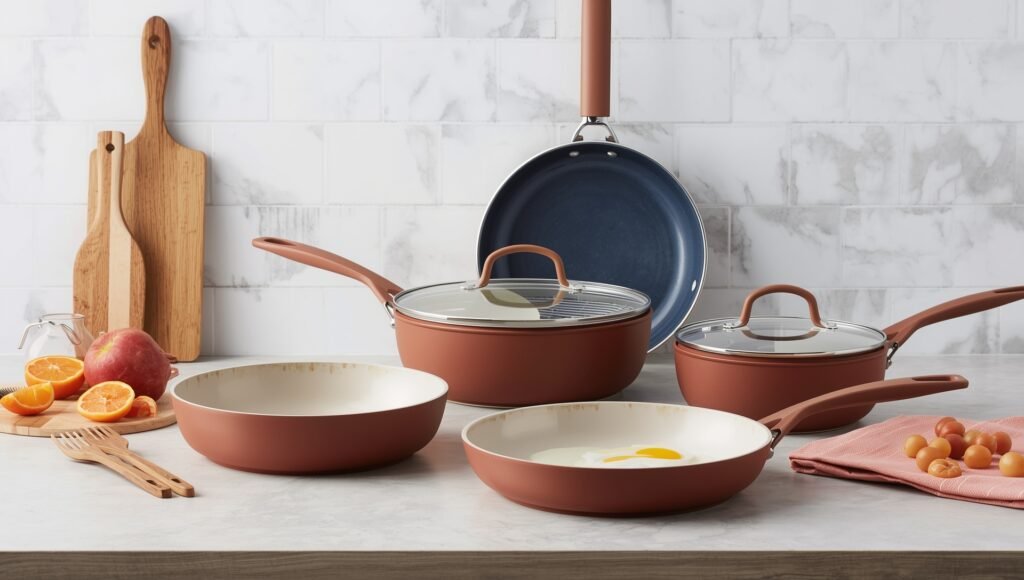
All-Clad D5 Stainless Steel (Best Premium Non-Toxic Cookware – Performance)
-
- Materials: 5-ply bonded construction (stainless steel, aluminum core, stainless steel) – inherently non-reactive and toxin-free.
- Tested Performance: Unmatched heat distribution and retention. Seared steaks perfectly, simmered sauces without scorching. Built to last generations. Dishwasher safe. Oven/broiler safe (600°F).
- Pros: Exceptional durability, professional performance, completely inert cooking surface.
- Cons: Higher learning curve (food can stick without proper technique), premium price, heavier weight.
- Best For: Serious cooks and professionals demanding top-tier performance and safety. Investment pieces.
- Price: Premium

Also See: Sustainable kitchen materials
Xtrema Pure Ceramic Cookware (Best 100% Ceramic Non-Toxic Cookware)
-
-
- Materials: Made entirely from solid, unglazed ceramic clay (no metals, glazes, or synthetics). Truly inert.
- Tested Performance: Requires slow preheating and lower temps but provides incredibly pure cooking. Excellent for slow simmering, baking, and avoiding metallic tastes. Naturally non-stick when seasoned. Oven/microwave safe (to 2500°F!).
- Pros: Purest non-toxic option, retains heat exceptionally well, versatile.
- Cons: Fragile (can chip if dropped), slow heating/cooling, not ideal for high-heat searing.
- Best For: Individuals with extreme chemical sensitivities or prioritizing absolute material purity. Excellent for sauces, grains, baking.
- Price: Premium
-
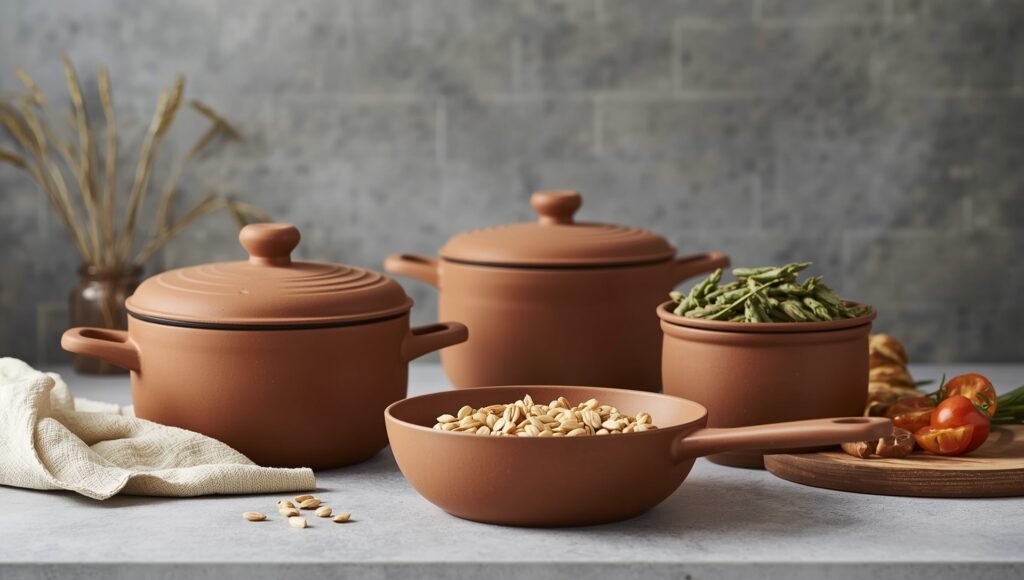
Lodge Cast Iron (Best Value Non-Toxic Cookware – Classic)
-
- Materials: Solid cast iron. Pre-seasoned with vegetable oil (no synthetic chemicals).
- Tested Performance: Unbeatable searing power and heat retention. Naturally non-stick when properly seasoned. Extremely durable. Oven/broiler safe (any temp).
- Pros: Incredibly affordable, lasts forever, versatile (stovetop, oven, campfire), adds dietary iron.
- Cons: Heavy, requires regular seasoning/maintenance, reactive with acidic foods (can leach iron, which is generally safe but can affect taste).
- Best For: Budget-conscious cooks, searing enthusiasts, those valuing durability and tradition.
- Price: Budget
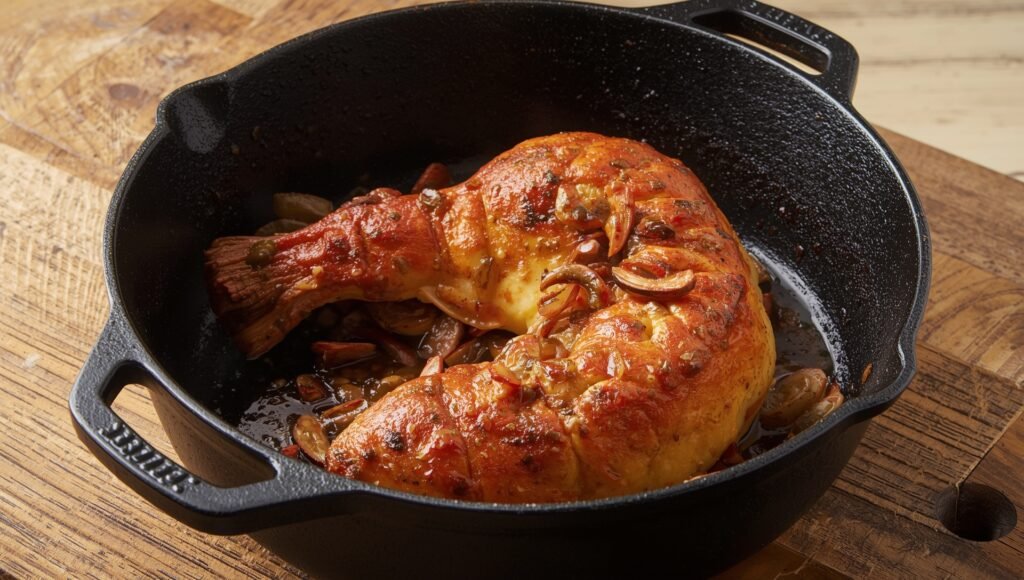
GreenPan Valencia Pro HD (Best Durable Ceramic Non-Toxic Cookware)
-
-
- Materials: Aluminum body with Thermolon™ Diamond Plus ceramic coating (PFAS-free, made from sand). Recycled stainless steel handles.
- Tested Performance: Testers noted significantly improved scratch resistance over older ceramic coatings. Excellent non-stick performance and even heating. Oven safe (to 600°F). Dishwasher safe (hand wash recommended).
- Pros: Stronger ceramic coating, comfortable handles, good heat responsiveness.
- Cons: Can still be scratched by metal utensils over time, premium pricing within ceramic.
- Best For: Those wanting robust ceramic non-stick performance with enhanced durability.
- Price: Mid-Range to Premium
-
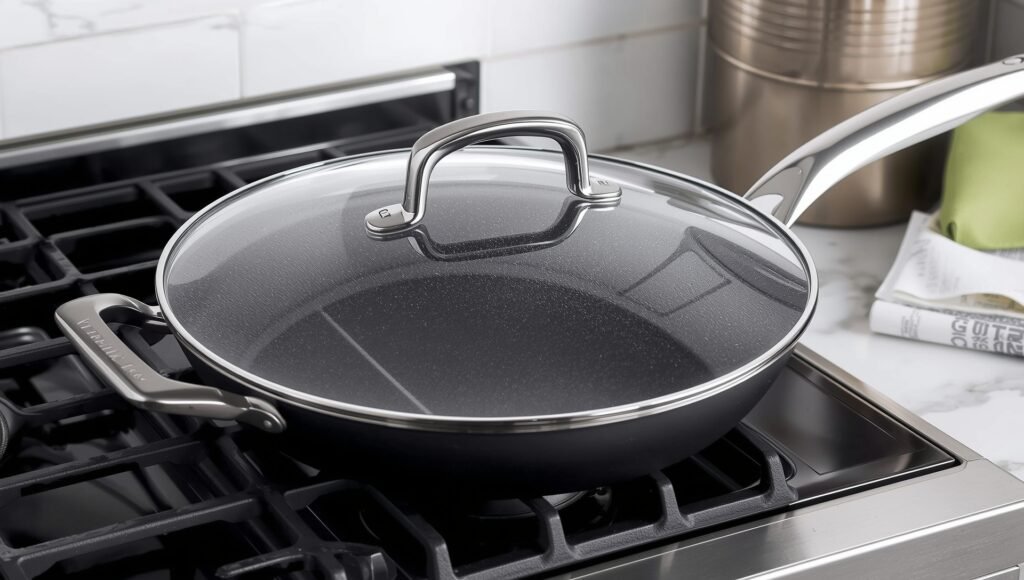
Le Creuset Enameled Cast Iron (Best Non-Toxic Cookware for Slow Cooking & Baking)
-
- Materials: Cast iron core with a durable, non-porous enamel coating (lead and cadmium safe).
- Tested Performance: Legendary heat retention and evenness. Perfect for braises, stews, sourdough, and baking. Effortless food release and cleaning. Non-reactive surface. Oven safe (to 500°F).
- Pros: Iconic durability, stunning colors, excellent non-reactive cooking surface, versatile.
- Cons: Very heavy, expensive, enamel can chip if struck hard.
- Best For: Discerning cooks who love slow cooking, baking, and owning heirloom-quality pieces.
- Price: Premium
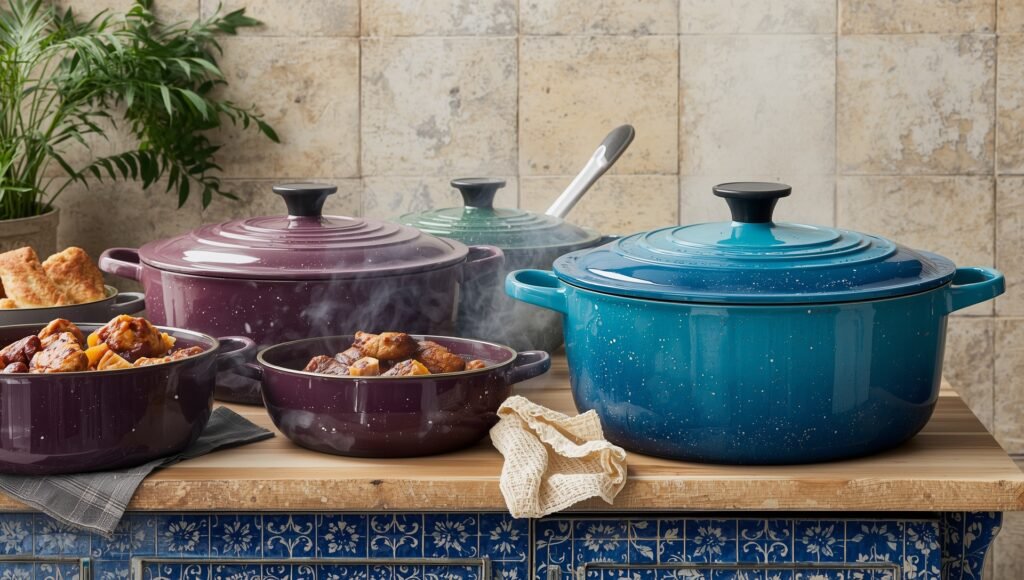
Homi Chef Nickel-Free Stainless Steel (Best Non-Toxic Cookware for Metal Sensitivities)
-
-
- Materials: High-quality 18/0 stainless steel (contains chromium, but 0% nickel). Inert cooking surface.
- Tested Performance: Provides the benefits of stainless steel (even heating in multi-ply versions, durability) without nickel, a common allergen. Excellent browning and deglazing.
- Pros: Safe for those with nickel allergies, durable, dishwasher/oven safe, non-reactive.
- Cons: Food sticking requires proper technique (preheating, oil), can be heavy.
- Best For: Cooks with nickel sensitivities or seeking the purest stainless steel option.
- Price: Mid-Range to Premium
-
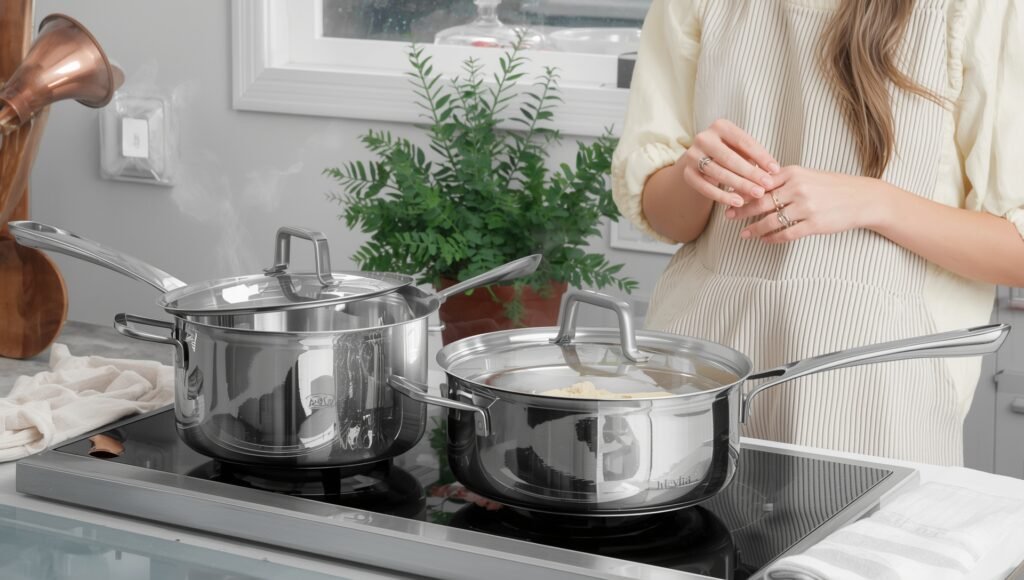
Our Place Always Pan 2.0 (Best Multi-Functional Non-Toxic Cookware Piece)
-
-
-
- Materials: Aluminum body with non-toxic, ceramic-based coating (PFAS/PFOA-free). Non-toxic thermoplastic handles.
- Tested Performance: Updated design improved heat distribution over the original. Testers loved its versatility (fry, steam, strain, sauté, etc.) and compact design. Good non-stick release. Oven safe (to 425°F).
- Pros: Space-saving, multiple functions in one, attractive design, easy cleaning.
- Cons: Not ideal for very high-heat searing, durability concerns with the non-stick coating under heavy use.
- Best For: Small kitchens, minimalist cooks, and those wanting a versatile everyday pan.
- Price: Mid-Range
-
-
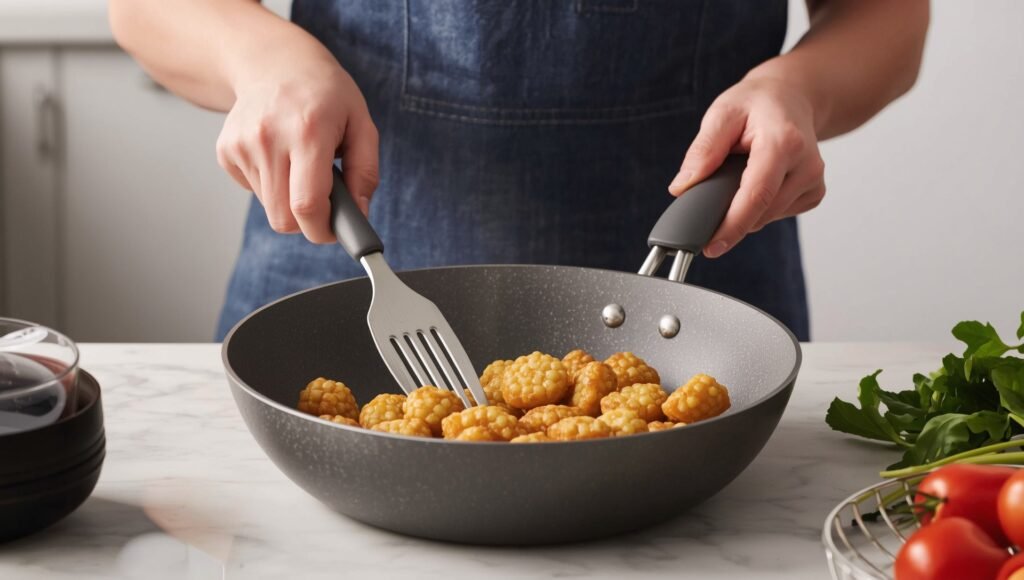
Made In Blue Carbon Steel (Best Lightweight Non-Toxic Cookware for Searing)
-
-
-
-
- Materials: Thinly rolled carbon steel, seasoned with non-toxic oil. Develops a natural non-stick patina.
- Tested Performance: Heats up fast and gets incredibly hot for perfect searing (steaks, fish, veggies). Lighter than cast iron but similar benefits. Oven safe (to 1200°F).
- Pros: Excellent high-heat performance, relatively lightweight, durable, develops character.
- Cons: Requires initial seasoning and maintenance, reactive until well-seasoned (can impart metallic taste), not dishwasher safe.
- Best For: Searing enthusiasts, wok-style cooking, those wanting a lighter alternative to cast iron.
- Price: Mid-Range
-
-
-
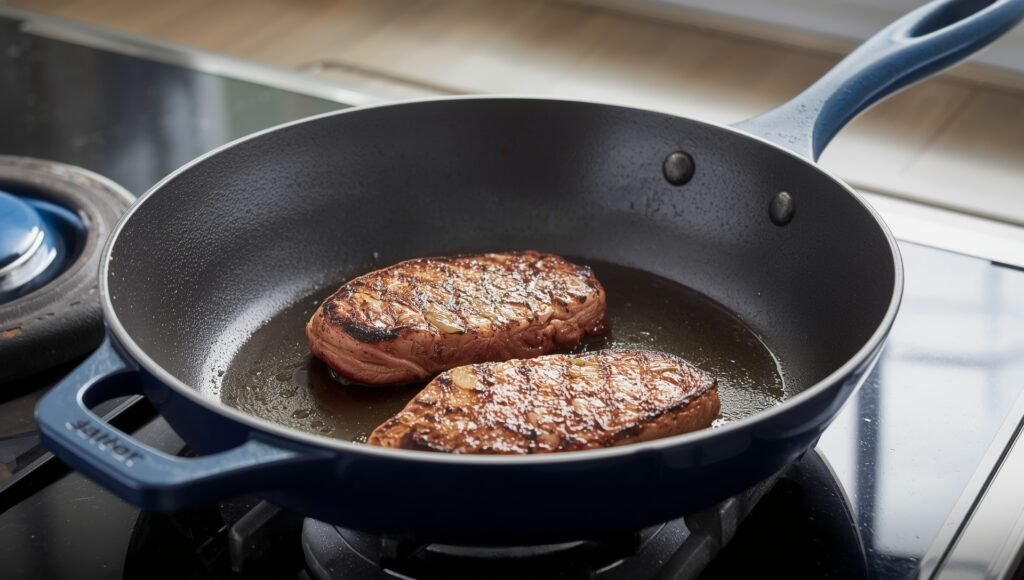
Green-Life Soft Grip Ceramic (Best Budget-Friendly Non-Toxic Cookware Set)
-
-
-
-
-
- Materials: Aluminum body with Thermolon™ ceramic coating (PFAS/PFOA-free). Colorful, non-toxic soft-grip handles.
- Tested Performance: Good initial non-stick performance and vibrant colors. Lightweight and easy to handle. Oven safe (to 350°F). Dishwasher safe (hand wash recommended).
- Pros: Very affordable entry point, cheerful designs, decent starter non-stick.
- Cons: Coating durability is lower than premium ceramic brands; prone to scratching and faster wear with frequent use. Lower heat tolerance.
- Best For: First-time buyers, students, budget-focused cooks needing basic non-stick.
- Price: Budget
-
-
-
-
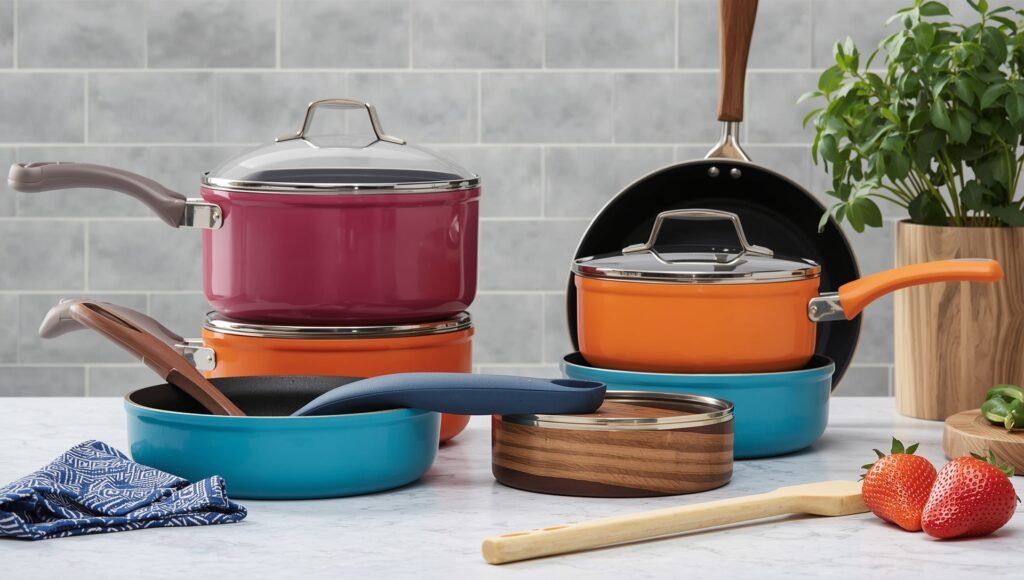
5 Pro Tips for Mastering Your Non-Toxic Cookware
- Season & Protect Cast Iron/Carbon Steel Religiously: A well-maintained seasoning layer is your natural non-stick barrier. Clean gently with minimal soap, dry immediately, and apply a thin layer of oil after every use. Avoid prolonged soaking.
- Embrace Medium Heat: High heat is unnecessary and often detrimental. Most non-toxic cookware (especially ceramic non-stick and enamel) performs best and lasts longer at medium temperatures. Preheat pans gently.
- Wood & Silicone Are Your Friends: Ditch metal utensils! Use wood, bamboo, or high-heat silicone tools exclusively on ceramic-coated, enameled, and seasoned surfaces to prevent scratches that compromise performance and safety.
- Prioritize Hand Washing: Even if labeled dishwasher safe, hand washing significantly extends the life of ceramic coatings, seasoning on cast iron/carbon steel, and the finish on handles. Use mild soap and non-abrasive sponges.
- Verify Certifications & Transparency: Don’t just trust “green” marketing. Look for specific, verifiable claims: “PFAS-Free,” “PFOA-Free,” “Lead & Cadmium Safe” (with Prop 65 compliance if applicable), and material composition disclosures. Reputable brands are transparent.
Conclusion: Invest in Your Health, One Pan at a Time
Choosing Non-Toxic Cookware is a powerful step towards a healthier home and a cleaner planet. By moving away from harmful chemicals like PFAS and opting for inert materials like stainless steel, pure ceramic, well-seasoned iron, or verified safe coatings, you reclaim control over what goes into your body. Our home cook-tested guide to the top 10 brands of 2025 provides a roadmap tailored to different needs, budgets, and cooking styles.
Remember, the “best” non-toxic cookware is the kind you’ll use consistently and care for properly. Start by replacing your most used pan – perhaps the flaking non-stick skillet or the aluminum pot. Invest in quality where it counts (like a Dutch oven or stainless skillet), and consider budget-friendly entry points for less critical pieces. Use our pro tips to maximize performance and longevity.
Your journey to a non-toxic kitchen doesn’t require perfection overnight. Make informed choices, prioritize verified safety, and enjoy the peace of mind that comes with cooking clean. Your health, your food, and your future self will thank you. Ready to ditch the toxins? Explore our top picks and make the switch to safer cooking today!
Top Asked Questions (Answered in the Article):
- What is the safest non-toxic cookware brand? (Addressed through testing methodology & brand reviews – e.g., Xtrema for pure ceramic, All-Clad/Homi for stainless, Lodge/Le Creuset for iron)
- Is ceramic cookware really non-toxic? (Explained in “What is Non-Toxic Cookware?” and brand specifics – Yes, if PFAS/PFOA-free and lead/cadmium safe like Caraway, GreenPan, Xtrema)
- How long does non-toxic non-stick cookware last? (Covered in Pro Tips and brand Cons – Varies; ceramic coatings less durable than stainless/cast iron, but improved in 2025 – e.g., GreenPan HD vs. Green-Life)
- Can you use metal utensils on non-toxic cookware? (Explicitly covered in Pro Tip 3 – Avoid on ceramic/enamel/seasoned surfaces; generally safe on bare stainless steel)
- What is the best non-toxic alternative to Teflon? (Core premise of the article – Ceramic coatings (Caraway, GreenPan), well-seasoned cast iron (Lodge), carbon steel (Made In), enameled cast iron (Le Creuset))
- Is stainless steel cookware non-toxic? (Explained in materials section – High-quality stainless steel (like All-Clad, Homi) is inert and non-reactive, making it a safe choice)
- How do you clean non-toxic cookware? (Covered in Pro Tip 4 and brand specifics – Generally hand wash recommended, mild soap, non-abrasive tools; specifics vary by material)
Thanks for reading!
For more green living tips, sustainable product reviews, and simple ways to make your home more eco-friendly, be sure to explore the rest of our blog. We’re here to help you live lighter on the planet—one tip at a time.
Visit our website Verdiuvo regularly for fresh updates and inspiration!
